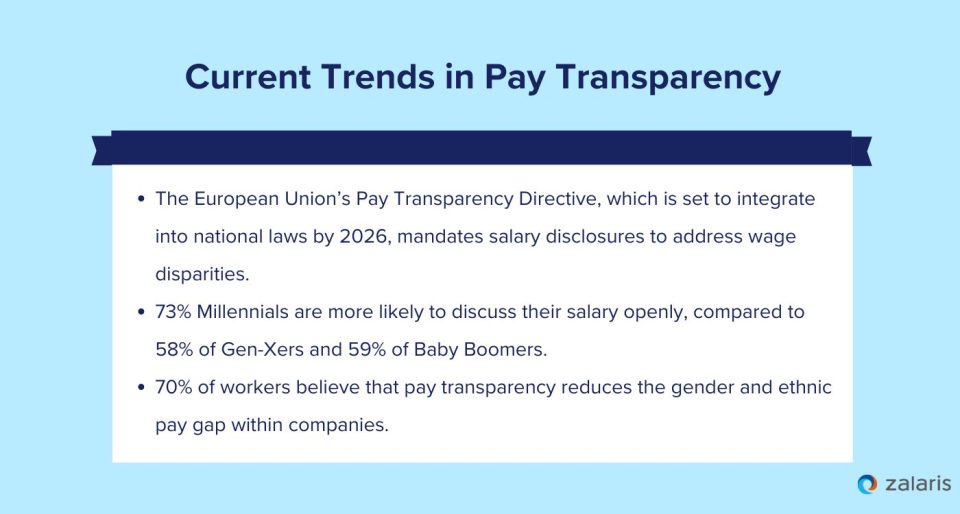In fact, a recent survey found that 58% of employees prefer working for a company that publishes salary information publicly.
Could this be the dawn of a new era in compensation, fostering equality and trust? Let’s uncover the transformative power of pay transparency and how it’s reshaping the corporate world.
What is pay transparency and why does it matter?
Pay transparency, simply put, refers to the practice of openly sharing information about employee compensation within an organisation. This can range from disclosing salary ranges for specific roles to publishing individual salaries. The significance of this trend cannot be overstated.
In recent years, a growing number of companies have embraced pay transparency as a core value. Why? Because it promotes fairness and trust. In fact, over 91% of employees who believe their company is transparent about pay decisions trust that their organisation pays people fairly.
In a time when employees crave authenticity and accountability, knowing that their pay is aligned with that of their peers can be incredibly reassuring. Current trends show a marked increase in organisations adopting some level of pay transparency, driven by regulatory changes, cultural shifts, and the demand for equitable workplaces.

While only 12% of organisations have fully developed and implemented a pay transparency strategy, nearly 75% are considering or planning to adopt such measures in response to these current trends.
The need for pay transparency: Unmasking the benefits
So, why is there such a clamor for pay transparency? The answer lies in its myriad benefits.
Fostering trust and engagement
Transparency is the first step to ensuring fairness and equality in the workplace. When employees understand how their pay is determined, it builds trust and accountability.
– Emma Watson, Actress and UN Women Goodwill Ambassador
As mentioned earlier, employees who understand how their pay is determined and feel assured that it is fair are more likely to trust their employers. This trust, in turn, drives engagement and productivity. When workers know their contributions are valued equally, they are more likely to be motivated and committed to their roles.
Promoting equity and inclusion
Pay transparency shines a light on disparities, making it easier to identify and rectify gender, racial, and other inequities in compensation. The push for pay transparency has been significantly influenced by social movements advocating for gender equality and fair compensation. The #MeToo movement and campaigns like #PayMeToo have highlighted gender pay disparities and prompted calls for greater transparency.
Legislative measures, such as the UK’s Gender Pay Gap Reporting requirements, have also mandated that companies disclose pay gaps, fostering a culture of openness. When pay structures are transparent, it becomes harder for unfair discrepancies to persist. This helps in closing pay gaps that have long plagued various industries. By ensuring everyone is paid fairly, companies can create a more inclusive and diverse workforce.
Attracting top talent
Job seekers today are increasingly looking for employers who are open about their pay practices. Transparency can be a significant selling point, helping organisations attract and retain top talent in a competitive job market.
Example: Buffer, a social media management company, has embraced pay transparency by publicly sharing their employees’ salaries online. This initiative has not only built trust but also attracted talent who value fairness and openness.
Challenges in implementing pay transparency: Navigating the hurdles
While the benefits of pay transparency are compelling, implementing it is not without challenges.
- Cultural resistance: Changing the status quo is never easy. Some companies may face resistance from employees and managers who are uncomfortable discussing salaries openly. It requires a cultural shift towards openness and trust, which can take time to cultivate.
- Privacy concerns: Not all employees may be comfortable with their salaries being disclosed, even in a range format. Balancing transparency with individual privacy is a delicate act that companies need to manage carefully.
- Complexity in execution: Establishing transparent pay practices involves overhauling existing systems, which can be complex and resource-intensive. It requires clear communication, robust data analysis, and consistent application to ensure fairness.
- Potential for discontent: If not managed well, transparency can lead to dissatisfaction. For instance, employees might feel undervalued if they find out their peers earn more, even if the pay difference is justified by experience or performance.
Simplify pay transparency with Zalaris’ Cloud Payroll Solution
Amid these challenges, Zalaris’ Cloud Payroll Solution emerges as a beacon for organisations striving to achieve pay transparency by making the journey towards it alot easier.
Zalaris’ Payroll Solution is designed to simplify and streamline payroll processes, making transparency more attainable. Here’s how it can help:
- Comprehensive data management: Zalaris’ solution provides a centralised platform to manage all payroll data, ensuring accuracy and consistency. This makes it easier to analyse and present pay information transparently.
- Comprehensive pay analysis: Zalaris offers advanced analytics tools that enable organisations to conduct thorough analyses of their pay structures. These tools identify pay disparities, highlight contributing factors, and support the development of targeted strategies to address inequalities effectively.
- Customisable reporting: With customisable reporting features, organisations can generate detailed pay reports that align with their transparency goals. These reports can be tailored to show salary ranges, individual pay, and other compensation details as needed.
- Compliance and security: Ensuring compliance with regulatory requirements and maintaining data security are paramount. Zalaris’ Payroll Solution is designed to meet these standards, giving organisations confidence that their transparency efforts are legally sound and secure.
- User-friendly interface: A user-friendly interface ensures that both HR professionals and employees can easily access and understand payroll information. This accessibility fosters a culture of openness and trust.
Know more on the topic
The future of pay urges you to embrace transparency
As we look to the future, the trajectory is clear: pay transparency is not just a trend but a fundamental shift in how organisations approach compensation. The journey toward full transparency will require effort and commitment, but the rewards – greater trust, equity, and engagement – are well worth it.
The role of technology, particularly solutions like Zalaris’ Cloud Payroll Soultion, will be crucial in this evolution. By providing the tools and frameworks needed to implement transparent practices, these solutions will help companies navigate the complexities and reap the benefits of a more open approach to pay.
In conclusion, pay transparency is more than just a policy; it’s a commitment to fairness and integrity in the workplace. As more organisations adopt this practice, we can expect a future where salary discussions are no longer taboo but a testament to the values of equity and trust that define the modern workplace.
The rise of pay transparency marks the beginning of a new chapter in the story of work, one where everyone knows their worth and is valued accordingly.

